
Catherine (Cathie) D. Wood's emergence into the Active Equity ETF space has brought an innovative, thought-provoking breath of fresh air to the publicly-traded investment world.
In October, as I was on my way between Oklahoma City and Southwest Florida, I was passing through east Alabama and west Georgia (along Interstate 20) when I was first introduced to one of the most intriguing investment managers of whom I have ever known. That introduction came via an interview on the “Bloomberg Advantage” radio program, when Catherine D. Wood and Arthur Laffer were special guests. This article may prove to be your introduction to Ms. Wood, as well.
The story began many years ago when Catherine D. Wood, an exceptionally bright student in economics/finance at the University of Southern California[1], was brought to the attention of Dr. Arthur Laffer (who was teaching at the USC Marshall School of Business at the time) – best known for his eight years of service on the Economic Policy Advisory Board during President Ronald Reagan’s administration. During that period, Laffer espoused the economic theory that asserts there is an optimum tax rate at which governments will garner maximum tax revenue[2] … a theory he illustrated through the use of the Laffer Curve.
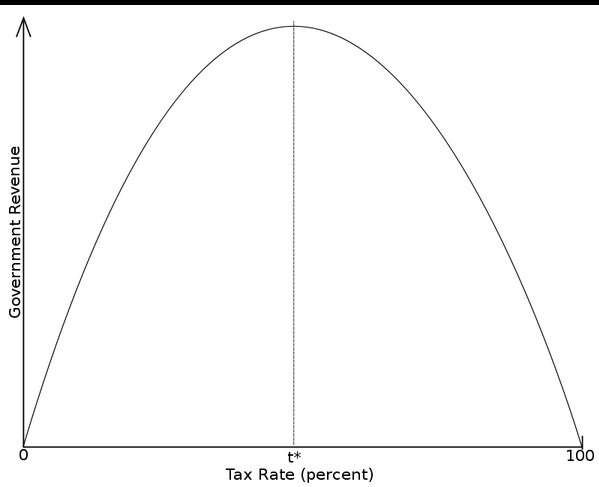
This is the famous LAFFER CURVE, which asserted that government would maximize its revenue at a certain tax rate -- generally lower than a level with which a fiscal dove (one who likes big government) would feel comfortable.
Laffer was so impressed by Wood that he began to mentor her in economics and business[3], helping to under gird her career by sharing his knowledge and network with her. However, it has been Wood’s innate intellect, curiosity, and unrelenting drive that have (since then) propelled her career. Woods resume includes these positions:
Capital Group: Assistant Economist (during her time at USC); Wood was introduced to Capital Group by Laffer;
Jennison Associates LLC : Managing Director … her responsibilities at Jennison included service as economist, equity research analyst, and portfolio management;
Tupelo Capital Services: Limited Partner… serving as a hedge fund portfolio manager, focusing upon thematic and macros strategies;
AllianceBernstein: Chief Investment Officer (2001-2013) with portfolio manager responsibilities[4] once again focusing upon thematic research strategies.
Along the way, Wood has maintained a connection with Laffer[5]. An interesting sidelight of the Bloomberg interview is the way in which it became obvious that, in many respects, Wood and Laffer have been mentoring each other because “the student” has matured and moved into areas of great promise that have peaked the interest of the original “mentor” (Laffer). Why do I say this? Because Wood’s obvious strength and passion lies in the area of innovative, disruptive technology; and when you review Laffer’s recent professional activities, they include serving as a board member of:
Pillar Data Systems: a non-public Data Storage Company tied to Larry Ellison;
Alpha Theory: a non-public Fundamental Portfolio Optimization software system marketed to hedge funds and mutual funds;
Collabrium Capital[6]: a United Kingdom emerging markets merchant bank providing corporate finance and fund management advice (especially related to private equity). Its customer base is primarily in Asia and Africa;
Executive Trading Solutions LLC: provides a comprehensive and scalable web-based solution that facilitates creation, administration, execution, and reporting related to Rule 10b51 stock trading plans. (Parallel to “RoboAdvisor” tech);

One of Laffer's most recent professional relationships has been serving on the Board of Consensus Point.
Consensus Point: provides an enterprise prediction markets platform that applies the power of crowdsourcing, mobile technology, and game theory to marketing solutions and consumer research data. Here is a slide depicting the company's focus:
At the beginning of this year, Wood officially opened up her own investment management firm: ARK Investment Management.
On September 30th, public trading was initiated on ARK’s first two ETFs: ARK Industrial Innovation ETF (ARKQ) and ARK Web x.0 ETF (ARKW). Then on October 31st, two more ETFs were rolled out: ARK Genomic Revolution Multi-Sector Fund (ARKG) and ARK Innovation Fund (ARKK).
OK, so we have four new equity ETF products. In an industry that (on average) sees 3-5 new products each week, what makes ARK’s products worthy of attention?
 The overriding reason why ARK ETFs should be of interest to investors is simply Cathie D. Wood. Maybe you feel like I do that many (most) of the fund managers and investment experts that appear on CNBC, Fox Business, or Bloomberg Business seem more like used car salesmen than thorough, widely read, research focused, data dependent investment managers. Compared to such business channel interviewees, Wood comes across as an investment giant among midgets.
The overriding reason why ARK ETFs should be of interest to investors is simply Cathie D. Wood. Maybe you feel like I do that many (most) of the fund managers and investment experts that appear on CNBC, Fox Business, or Bloomberg Business seem more like used car salesmen than thorough, widely read, research focused, data dependent investment managers. Compared to such business channel interviewees, Wood comes across as an investment giant among midgets.
At the heart of Wood’s competitive advantage is her ability to integrate a strong economic knowledge basis within the current investment environment. That gives Wood a perfect perspective through which to conceptualize how disruptive tech innovators can transform the economy and society. Importantly, she doesn’t just satisfy herself with a cursory understanding of the selling points of modern technology products and services. Instead, she seeks out and absorbs the detailed dynamics related to these transformations, as well as the metrics through which to measure them. I know nothing of Wood’s personal life[7] but she is always in such command of the facts, data-established trends, and a fundamental understanding of current markets that one might think she studies technology trends, her portfolio holdings, and the securities markets 24/7.
Here are a couple of samples regarding Wood’s approach to investing from recent Bloomberg Business interviews:
Wood on investing in disruptive technology (her interview starts at the 3:11 mark on the audio): http://media.bloomberg.com/bb/avfile/vm5FKNkONtlA.mp3.
Wood/Laffer interview on October 21 (starts at about the 2:07 mark of the audio): http://media.bloomberg.com/bb/avfile/vLQW0Y8rrhRg.mp3
Wood/Laffer interview on October 22: http://media.bloomberg.com/bb/avfile/v9clwGJng4TQ.mp3
If you took a few moments to listen to Wood, you were introduced to her quite different way of thinking about the economy, technology, and investing, such as:
Disruptive technology has been, and continues to be, so disruptive and transformational that governmental economic reports are becoming increasingly misleading[8]. Consider this example:
Wood peppers her investment commentary with terms such as “Stranded Asset” and “Sharing Economy”…
Think about the average U.S. automobile. Did you know that (on average) we spend only 4% of our time in our car? That means that during 96% of the average day, our car is a non-productive asset! In Wood’s lexicon, it is a “Stranded Asset”.
Enter “Car Sharing”!! If we participate in car sharing, our car asset becomes more productive!! Collateral impact over time would include:
a) Reduction in the cost of owning a car;
b) Decrease in auto sales.
In Wood's view, that would be a positive. An aggregate increase in the car sharing economy would reduce auto sales, but it would also lower costs and raise productivity… making the U.S. economy more efficient!
Wood points out that if penetration in the “Sharing Economy” moves to just 5%, then in five years (within a great economy) auto sales would drop from the current 16-17 million units to just 7-8 million units!
Of course, within the current economic paradigm, that statistic would lead to an extremely high risk of commentators at CNBC experiencing either cardiac arrest or an apoplectic fit! And yet in Wood’s view, it would be a positive because a stranded asset has been activated and the economy has become more efficient.
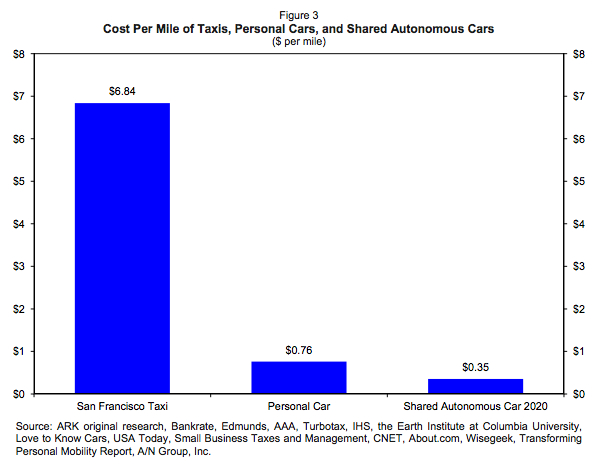
"Shared Auto" costs average half those of a "Personal Car"... and are about 0.5% of the cost of a Taxi!
But that is not all, my friends… within a U.S. that has increased the efficiency and utilization of the automobile (on an aggregate basis) and led to fewer cars, less parking spaces will be needed, freeing up real estate for more productive utilization!!
No, my friends, Cathie Wood is not your grandparents’ economist… nor your parents’ futurist… she is an economic/investment futurist for 21st Century investing!
I can tell by the look in your eyes that you are intrigued[9]. So here are two more graphs. Given what I have written above, it should come as no surprise that Wood is a great believer in the economic benefit of automation. Her research on the historical impact of automation combined with her ability to recognize current trends enables her to offer rough projections into the future regarding the economic benefit of automation at the individual employee level:
and at the national level ($11.6 trillion added to annual GDP by 2035):
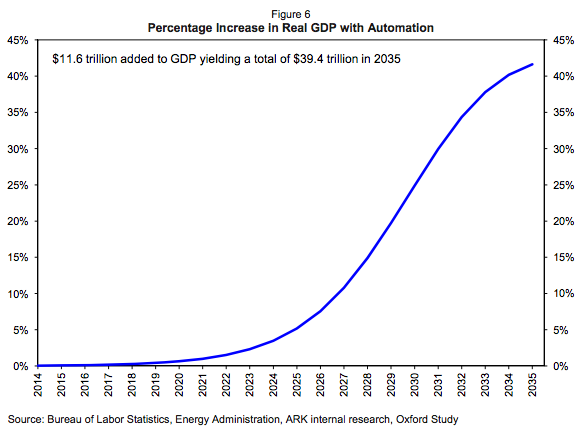 Here are just a few more insights into Wood from her Twitter page. Take a good look at how she describes herself [10]:
Here are just a few more insights into Wood from her Twitter page. Take a good look at how she describes herself [10]:
Among Wood's many tweets, here is a graph that is typical of the data-driven informational base upon which she rests her investment theses… a graph of “Average Revenue Per User” (ARPU)[11] that attempts to adjust the standard, over simplified, comparisons between Facebook (FB) and Twitter (TWTR) in recognition of their differentiated usage patterns.
Expressed more simply: considerably less time is needed to access info through TWTR than through FB. Therefore, adjusting for time offers a quite different view of how effectively these two social media giants monetize their user base!
Finally, you read within her TWTR self description that Wood is a women’s advocate. In the midst of the intense demands on her time serving as portfolio manager, researcher, economist, and innovative thinker, Wood finds time to chair “Women’s Voices for Change” … and if you check the group’s website, you will find her small photo and entry listed at the very bottom of the list of Directors (demonstrating an uncommon degree of humility– particularly uncommon among leaders in the investment industry!).
I trust that, by now, you have gained an appreciation for the depth, breadth, and range of Catherine D. Wood’s thinking, knowledge base, and commitment to detailed research… translated into the real world dynamics of the existing and soon-to-be global economy. This woman is not your standard investment manager, nor does she find herself in a position wherein her creativity and her innovative thinking are held back by a corporate management that is unwilling to risk being “on the edge” of standard Wall Street thinking. Indeed, within that world so often dominated by copycat portfolios and the superficial recitation of current “hot button” terminology[12], Wood sticks out like a diamond in the midst of cubic zirconia (or worse, the heavy, very transparent glass used since the days of ancient Rome to create fake gemstones).
All four of Wood’s ETF’s are too new for me to even hint at a recommendation to buy at this point. However, that being said, all four of them are intriguing and (more importantly) quite different than your standard existing ETF. In fact, Wood makes a compelling point in her interviews that (in the sense of traditional “active management” based upon daily manager judgment) ARK is the only truly “active manager” within today’s equity ETF space. The existing ETFs that you might presume are “active” are really based upon a designated index and are managed according to (and in tandem with) their respective index.[13]
The most commonly understood reason that (before ARK, at least) equity ETFs have been index-based is that the best portfolio managers have not wanted to be compelled to comply with the SEC requirement of “daily portfolio disclosure”! “Wall Street” has felt that making daily portfolio disclosure is akin to Coca Cola (KO) revealing in detail the formula of its iconic soft drink. Making its “best ideas” public on a daily basis is not how Wall Street has cared to operate.
In sharp contrast, Wood’s ARK makes daily disclosure of its holdings, publishes research white papers, and encourages other individuals to connect with ARK and participate in its innovative thinking process! If you want to read the detailed whitepaper referred to by Wood during the Bloomberg interview (the same whitepaper from which the earlier graphs were provided regarding car sharing and automation) you can access it at:
In future articles, I plan to detail for you each one of Wood’s portfolios. I assure you that you will be both surprised and impressed by her approach! So keep looking here in weeks to come. You won’t want to miss them!
DISCLOSURE:
The author does not own any of the ARK funds (yet). The author has never met Ms. Wood or Dr. Laffer. And the author has no connection whatsoever with ARK Investment
Management (ie. I have not and will not receive any form of compensation from ARK for this article.) In fact, the only connection I have been able to find between me and Laffer, Wood, or ARK is that Laffer was born in Youngstown, Ohio in 1940, while my mother was still legally resident there (although attending Purdue University). You’ll have to trust me that baby Laffer did not ask her to get me to write this article 74 years later!!
FOOTNOTES:
[1] She graduated Summa Cum Laude
[2] Note that the theory would suggest that the current U.S. tax rate is much higher than the “optimum rate” for maximum revenue. The theory would also suggest that if the U.S. corporate tax rate was much lower, no U.S. company would have been motivated to execute a “Tax Inversion”
[3] Laffer secured approval from the Business School to allow Wood (an undergrad) to enroll in his graduate level class.
[4] At AllianceBernstein, Wood managed $5 billion in assets … delivering exceptional long-term investment returns.
[5] In fact, in the Bloomberg interview, Laffer described Wood as his investment adviser.
[6] Laffer is on the “advisory” board rather than the fiduciary board.
[7] All I know is what she has posted in LinkedIn, within the “Women’s Voices for Change” website, and on her ARK website.
[8] Wood is not referring, through that premise, to the manipulation of government economic data (eg. BLS data) but to governmental economic statistics that are becoming outdated because of disruptive tech!
[9] OK… I also see that a few are stunned. But you get the point!
[10] I love the “AH-HA moment seeker” description.
[11] The total revenue divided by the number of subscribers.
[12] Informally listed in the virtual “Official Lexicon of Wall Street Speak” – a lexicon I personally witnessed evolve over some 30 years of sitting through interminable investment committee meetings listening to one manager after the other review their portfolio performance… taking full and certain credit for every basis point of outperformance (vis-à-vis the benchmark) and (of course) disclaiming responsibility for every basis point of underperformance.
[13] For example, whenever a change is made in the index, the portfolio changes accordingly.
Related Posts
Also on Market Tamer…
Follow Us on Facebook





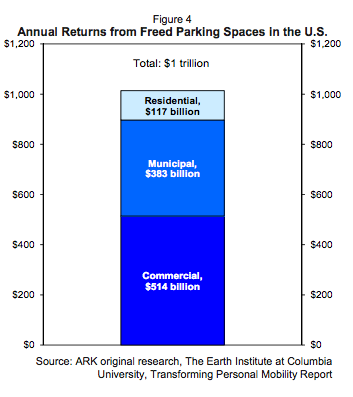
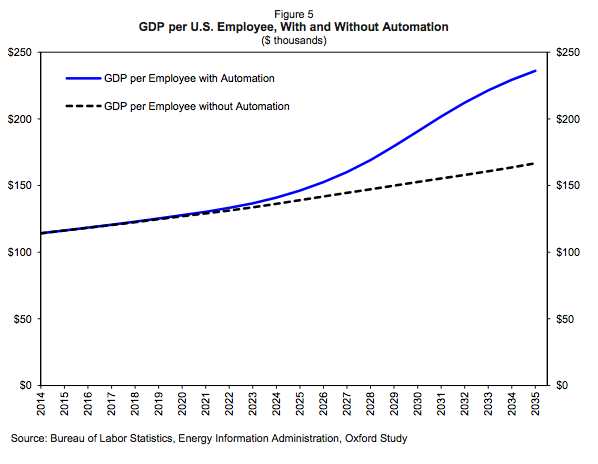

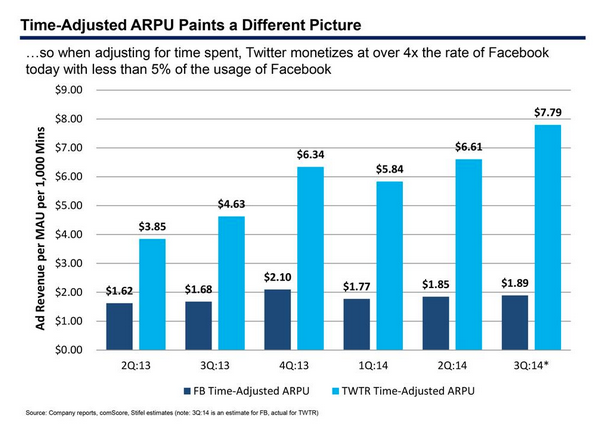

 You Don't Need Talent to Succeed: Lessons From Warren Buffett's Lifetime of Investing
You Don't Need Talent to Succeed: Lessons From Warren Buffett's Lifetime of Investing
